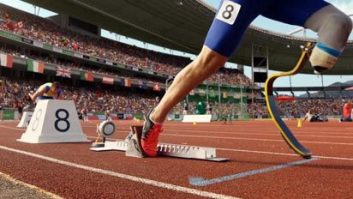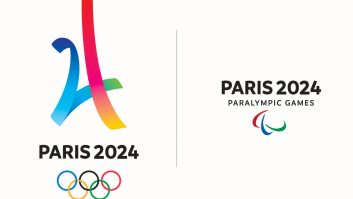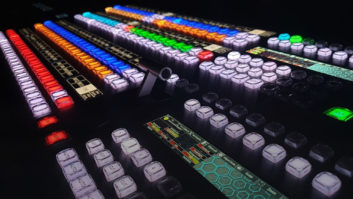L’EQUIPE 21, la première chaîne 100% sport, 100% gratuite. One hundred percent sport. One hundred per cent free. That’s the slogan of L’Équipe 21, the French sports channel launched in 2012. To ensure French fans are continuously fed with action and information from their favourite sports, a summary of the sports news is updated every 15 minutes. Earlier this year, the Paris-based broadcaster moved to a new production centre also occupied by the parent company, L’Équipe – the well-respected sports newspaper.
“Our two studios are located in the Boulogne,” states Philippe Espinet (pictured), chief technical office of the broadcaster. “One has a fabulous view of the Eiffel Tower, while the other has been built with a virtual set.”
The cameras deployed in these studios are Sony BRCH900. These are fully automated through an in-house system and controlled remotely using Wi-Fi. Just one operator controls shots, movements and racking.
The virtual set is built around a Neon trackless system from Hybrid. This unit eliminates the need for both external tracking devices and an external chroma keyer, and enables camera movements to be simulated from a fixed SDI signal. Boards within the equipment allow the VR studio to be controlled through the GPI triggering of the Kahuna 360 vision mixer.
The relocation allows the channel to introduce significant enhancements to its production tools, newsroom operations and playout infrastructure. And to do that it turned to the Dalet Sports Factory end-to-end news, studio production, broadcast and media asset management system.
“We were determined to deploy a system that was fully integrated,” emphasises Espinet. “We didn’t want different production silos that existed when the channel started. And there was an obvious operational rationale for this decision. First, the users are primarily journalists and the Dalet system has all the tools they need within the system. This makes the workflow more efficient and it certainly made the training easier because they could accomplish all their tasks on the same desktop. This was especially important as we had a very short turnaround – just four months — from order-signing to on-air.”
Espinet states that the second reason for an integrated system was financial. “A single, main system to run NRCS plus ingest plus production plus playout plus archives results in monetary savings. Separate and multiple systems are also harder to administer and maintain. With a single Dalet system we also have the benefit of support from a single vendor with resultant cost savings.”
No cache storage
In all, 100 Windows clients with desktop editing and Vizrt plugins were installed. Other essentials of the system include 20 web clients, 22 ingest automation, 15 ENG ingest and 10 file-based ingest servers. There are also in excess of 100 back office logical application servers to manipulate video, a Rundown editor, A/B roll playout and eight carts for video walls and the automated playout control of graphic elements. Other basics include integration with a number of other operations – Oracle ZFS storage for the archives, four Xtend for Final Cut Pro, a traffic system, and eight Dalet Brio servers.
“The Dalet system is not only modular, but it also addresses different market segments,” explains Raoul Cospen, director of Marketing and Business development at Dalet. “L’Équipe 21 is a typical example. The broadcaster uses newsroom modules, sports modules and other tools that are dedicated to programme MAM activities, such as archive operations like indexing and searching. There is even integration with the traffic system to handle commercials automatically.”
“The Dalet Brio servers with their 22 inputs and 12 outputs are used both for ingest and playout. They are integrated into the Dalet system using API commands. The storage is actually located directly on the SAN, allowing files to be read and written directly on the network.”
Espinet goes on to explain why the Dalet architecture was of special interest. “For ingest and playout, we are using the Brio servers directly connected to the SAN using Fibre Channel. Video material is ingested both in high-res DVCPro 100 and proxy at the same time directly on the SAN server for immediate production. When it is time to play out, this is done directly out of the SAN using Brio servers. There is no cache storage in the servers.”
This arrangement not only makes for an efficient workflow, but also this configuration means no extra application servers are needed to handle transfers and conversion to proxy. This results in financial savings both on the servers and the required bandwidth of the production SAN.
Cospen goes on to say that the Dalet system also allows the easy administration of matters such as rights management. “Even when content is edited outside Dalet, on FCP, for example, the rights and other metadata are tracked and maintained during the entire cycle of the workflow. Even throughout craft editing, there is no metadata destruction.”
In order for the new operation to be effective, material stored on the previously used system had to be imported. The first task was to create metadata fields in the Dalet system that matched existing fields. Once this was completed, a specially designed tool within the Dalet Sports Factory was used for the mass import of metadata and media.
Everyone an editor
Of special importance to the channel was the integration of graphics with the newsroom system. That graphics set up includes four Viz Trios (CGs) in the control room that drive a playlist of graphics used live on air. A Viz Engine renders the graphics in realtime for each Trio. The channel also uses a single Viz Ticker to take in live data from various sources and displays it as text in the ticker. The graphics team has a single Viz Artist workstation to do all of their design work.
Cospen reveals that the integration between Dalet and VizRt is significantly advanced at L’Équipe 21. “From their workstations, users can add graphic objects from the script editor or from the Dalet timeline, using the VizRt activeX to select templates and to enter text. When a new graphic is added to the timeline, VizRt automatically generates a proxy resolution of the full graphic animation that can be seen in the preview window from any workstation. Graphics are either burnt or played automatically as secondary events during playout. This is an advanced and unique integration between both systems that is way beyond usual intelligent interfaces and MOS integrations.”
He says that with the innovative ‘CG on the Timeline’ feature, journalists can select a graphic template, fill in the relevant data and place it on the video. This allows the graphics to be attached as metadata to the video and played out automatically.
Although most of the editing is completed from the producer/journalist workstations, there is also the option to create a rough cut, make a shot list or a simple EDL that can be opened by a craft editor using Final Cut Pro 7. Voiceovers are recorded directly from a user’s workstation using a microphone on the desk. There are also two voiceover booths, usually deployed to record phone interviews directly into Dalet.
This editing and voiceover capability is singled out by Espinet as particularly important in the production cycle at the channel. “The thrilling aspect is the new approach for video editing. Before, all editing was carried out by craft editors. Today, all the users have access to video assets and to the tools to edit video, record voice-overs and position their graphics. This dramatically increases productivity, with a better circulation of the information and added agility to the workflow.”
He goes on, “It is never easy to switch from one system to another — especially when you have very little time for training and the tools are new to the staff. But the new workflows and tools were really well received by the staff. Importantly, there is no bottleneck in the workflow. In fact, we don’t even have a backup system. This is the proof that the system is really stable!“
By Philip Stevens







